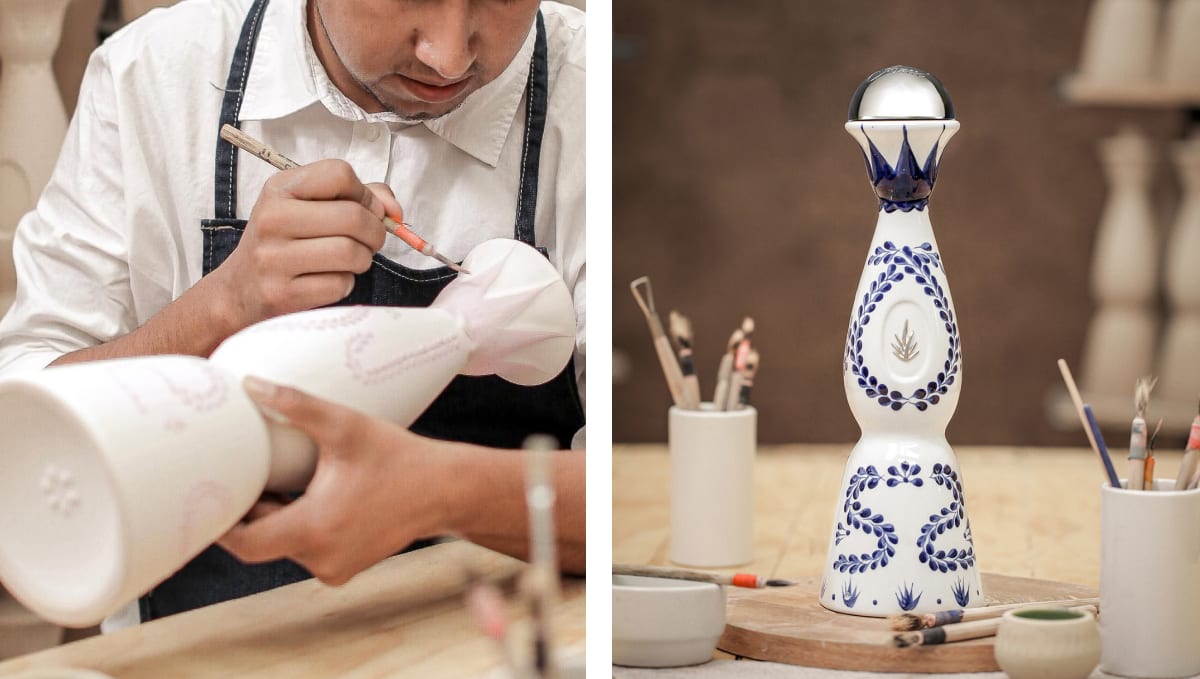Clase Azul Tequila

The Ultimate Guide to Clase Azul Tequila
The first time you see a Clase Azul bottle, you know you’re in for something special. Its hand-crafted ceramic decanter is practically Mexican folk art, and the beauty’s not just on the outside - what’s inside will make you fall in love with tequila all over again.
If you’re ready to explore Clase Azul’s premium allure, from its origin story to how to drink it (hint: slowly), read on.

Image courtesy of Clase Azul
Join Whiskymofo for exclusive member pricing on Clase Azul.

What Makes Clase Azul Special
Quality Ingredients & Artisanal Production
Clase Azul is born from 100% organic Blue Weber agave harvested in the highlands of Jalisco. These agaves are no youngsters either; they’re allowed to mature around nine years before harvest, soaking up the rich red soil and sunshine until just right. When harvested, the piñas (agave hearts) are then slow-cooked for 72 hours in traditional brick ovens to coax out deep, sweet flavours.
Fermentation uses a proprietary yeast, and distillation is done in copper pot stills the old-school way, ensuring a pure, rich spirit drop-by-drop. This painstaking, slow food approach to tequila-making is rewarded in every sip. Patience and tradition: it rarely under delivers.

Handcrafted Bottles & Mexican Artistry
It’s worth reiterating how damn special these extremely collectible decanters. The design is inspired by Mexican Talavera pottery, and in the case of the Añejo (we’ll get to that), the motif pays tribute to the Mazahua indigenous culture.
Local artisans mold and paint each and every ceramic decanter by hand - you can literally see brush strokes and feel unique variations with your finger tips that proves it’s not mass-produced.
But perhaps the most fun part? The bell. Yep, the ceramic topper on Clase Azul bottles has a tiny bell inside; give it a tap and it rings, announcing that a special tequila is being opened. And if you ring the bell, you have to take a sip - we don’t make the rules.

Exceptional Flavour and Smoothness
Of course, all the craftsmanship in the world means nothing if the tequila doesn’t deliver. Thankfully, Clase Azul tastes as spectacular as it looks. The slow cooking and careful distillation yield a spirit that is ultra-smooth and rich, and each expression has its nuances (more on that below).
Exclusivity & Authenticity
Clase Azul isn’t produced in some giant distilling operation. It’s made in relatively small batches, with a meticulous eye on quality. This, combined with the artistry and the brand’s cult status, means it’s often in limited supply and high demand.
Even the company’s ethos reflects a respect for culture and sustainability: supporting local artisans with fair wages, replanting agaves, and generally not behaving like a soulless corporation. Tick, tick, tick.
Get notified when Clase Azul deals become available.
Clase Azul - A Guide to the Main Expressions
Whether you’re a tequila novice or a seasoned sipper, it’s worth getting to know the big three Clase Azul expressions: Plata, Reposado, and Añejo.
Here’s what each has to offer (besides looking magnificent on your shelf).
Clase Azul Plata (Silver)

The Plata is Clase Azul’s un-aged blanco tequila, aka the purest expression of the agave, bottled straight after distillation (no resting in oak here). Don’t let “un-aged” make you think it’s raw or harsh, though. Clase Azul Plata is remarkably smooth and fresh, a testament to that painstaking production process.
In the glass it’s crystal clear (they even filter the spirit to ensure perfect clarity), and greets you with herbal and citrus notes: think fresh agave sweetness, a touch of orange peel and lemon, maybe a hint of cracked pepper.
On the palate you’ll likely notice a soft vanilla sweetness intertwined with the earthy, vegetal agave flavours. It’s light to medium-bodied, super easy on the palate, and finishes clean with a bit of lingering sweet peppery warmth.
While it’s the entry-level of Clase Azul’s lineup, there’s nothing “basic” about it; this is a top-shelf blanco that will ruin tequila for you forever, in the best possible way.
Clase Azul Reposado

Reposado is arguably the flagship of the Clase Azul range - the iconic white ceramic bottle with bold blue paintwork, inspired by traditional Talavera pottery, that often serves as many people’s introduction to Clase Azul.
Reposado tequila, by definition, is tequila “rested” in wood. Clase Azul Reposado spends a solid eight months in ex-bourbon American whiskey barrels after distillation, taking on a soft amber hue and a flavour profile that’s dangerously smooth.
Stick your nose in the glass and you’ll get warm aromas of cooked agave, vanilla, and caramel, maybe a drizzle of toffee and a whiff of oak.
Silky and rich on the palate, you’ll taste notes of creamy caramel, vanilla, and a hint of spice, balanced by the agave’s natural sweetness and a subtle woody underpinning from the oak. The finish is long, mellow, with a lightly sweet afterglow - a gentle reminder that you’ve had something fine.
Savour it neat; trust us, mixing Clase Azul Reposado into a Margarita would be like using a Rembrandt painting as a dinner placemat.
This is the one to pull out for a celebratory toast or a gift to someone who has a deep appreciation for fine spirits. Just don’t forget to ring that bell before you pour.
Clase Azul Añejo

We’re in truly rarefied territory here. While Mexican regulations require a minimum of one year aging for an Añejo, Clase Azul takes it further; their Añejo is aged a generous 25 months in American whiskey barrels.
The tequila takes on a deep amber that could almost be mistaken for a fine cognac in the glass; on the nose you’ll find layers of oak, caramel, and toasted oak spice on the nose, along with dried fruits (think raisins or fig) and maybe a hint of cinnamon and orange marmalade.
On the palate it’s an absolute cascade of flavours: toffee, dark chocolate, rich agave nectar, roasted oak, and spices like clove or cinnamon, all dancing together. The mouthfeel is velvety and warm; despite the richness, it’s still impossibly smooth, any edges well-rounded by time and wood. It’s the kind of drink you close your eyes to fully appreciate, maybe paired with a piece of dark chocolate if you’re feeling decadent.
Clase Azul Añejo is decidedly luxurious and priced accordingly; this is a special-occasion spirit for most of us. If you ever get to taste this one, do so under the right circumstances: a relaxed evening, a great piece of music playing, maybe good company if you’re in the mood to share. The kind of moment you’ll want to remember, just like the tequila.
Worth noting: There are even more extravagant Clase Azul editions beyond Añejo – such as Ultra or special Limited Editions, but those are extremely rare and come with price tags fit for royalty. Who knows though, maybe you’ll see a bottle dropping or two dropping for one of our main events…

How to Drink Clase Azul
To truly appreciate Clase Azul, you’ll want to treat it the way you would a fine single malt or a well-aged cognac. Sip, reflect, and enjoy: that’s how Clase Azul is meant to be experienced.
Use the Right Glass
If possible, pour your Clase Azul into a proper sipping glass. A Glencairn whisky glass or a snifter works great, as does a designated tequila tulip-shaped glass. If you don’t have fancy glassware, even a nice wine glass can do in a pinch - anything with a bowl and narrowed top to trap the aromas.
Temperature Matters
Serve it neat at room temperature or only slightly chilled. If you’re in a hot climate, you might refrigerate the bottle slightly or chill your glass, but generally avoid loading your glass with ice. It’ll dilute that Jalisco sunshine.
Sip It
This might seem obvious, but to emphasise: sip it. Let it roll around your tongue. Notice the texture, the sweetness, the spice. Clase Azul has a lot going on, and if you just throw it back, you’re wasting half the fun (and lets face it, a lot of money).
Savour the Moment
Set the mood. Clase Azul is often enjoyed during special occasions or moments of indulgence. Maybe it’s a celebratory toast, a gift you received, or just a well-deserved nightcap after a long week. Perhaps pair it with some nice dark chocolate, or authentic Mexican food if you want to go all-in (few things are as luxuriously satisfying as a sip of Reposado following a bite of rich mole poblano).
Remember to Ring the Bell
As mentioned, for some editions the bottle’s cap has a built-in bell. It’s become the Clase Azure ritual to ring it before pouring; a way to say “something special is about to happen.” Go ahead and give it a gentle ring, acknowledge you’re opening more than just a pretty decanter.
Clase Azul Value & Member Benefits
Okay, let’s address the elephant in the room: Clase Azul is not cheap. In fact, it’s one of the priciest tequila brands you’ll encounter on the market. You’ll see Clase Azul Reposado in Australia retail at $350+, Plata around $289+, while the Gold and Ultra Añejo variants are significantly higher.
But if you’re looking to snag a bottle of Clase Azul at a best-in-market price, being a Whiskymofo member is the smartest move you can make.
As a member, you get access to exclusive deals and first dibs on rare bottles, at up to 40% off what they retail for elsewhere. Clase Azul, especially the Reposado and Añejo, absolutely qualifies as the kind of rare icon product that tends to sell out quickly when we have some available.
You might see limited allocations pop up (not for long), and being part of Whiskymofo means you’ll be notified as soon as they do - so you can secure that elusive bottle of Clase Azul when we have it, without paying full RRP.
